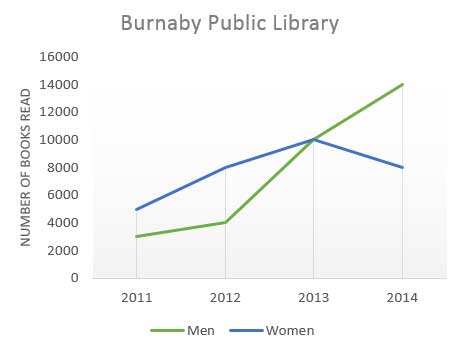IELTS Writing Task 1 Public Library IELTS Writing Task 1 Public Library Instructions Visual Data The graph above shows the number of books read by men and women at Burnaby Public Library from 2011 to 2014. Write a summary of the information given in the graph by selecting and reporting the main points. You could make comparisons when necessary. LELB Society's Student: Sasan The graph depicts the number of books read by both genders at Burnaby public library from 2011 to 2014. In 2011, women were more active than men in terms of reading books, reading almost 5000 books which was 2000 more ...
Home » IELTS Essay Writing Practice » IELTS Writing Task 1 Public Library

IELTS Writing Task 1 Public Library
Updated: by Dr. Mohammad Hossein Hariri Asl
Time to Read: 3 minutes | 331 Views | 4 Comments on IELTS Writing Task 1 Public Library
Share This Post
About the Author
Dr. Mohammad Hossein Hariri Asl is an English and Persian instructor, educator, researcher, inventor, published author, blogger, SEO expert, website developer, entrepreneur, and the creator of LELB Society. He's got a PhD in TEFL (Teaching English as a Foreign Language).
Number of Posts: 4242



Great article, totally what I wanted to find.
Great to hear that. Good luck!
The graph depicts the number of books read by both genders at Burnaby public library from 2011 to 2014.
In 2011, women were more active than men in terms of reading books, reading almost 5000 books which was 2000 more than the number of books read by men. Fortunately, with the passage of time, reading books came to vogue more tangibly among both genders. However, the women’s growth in reading books was faster than men’s from 2011 to 2012. Surprisingly, the men’s rate of reading books soared faster than women’s from 2012 to 2013 in which the number of books read by women reached its apex (about 11000). In fact, in 2013, the number of books read by men commenced to outstrip that of women. In the last year, women lost their thirst for reading books and finally, the number of books read by them reached 9000, approximately. Nevertheless, in the last year, men were more preoccupied with reading books compared to women and they read 15000 books in 2014, roughly.
Dear Sasan,
Thank you so much for submitting your IELTS essay on public library to us for assessment and analysis.